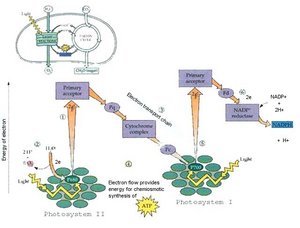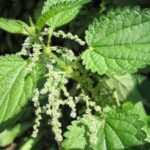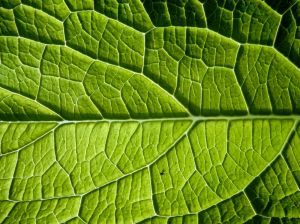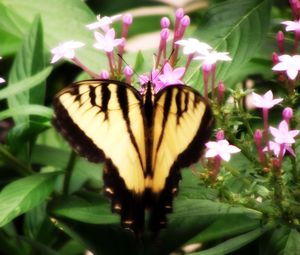This is a guide to photosynthesis designed for students in introductory-level biology courses. Open the accompanying pictures or any other pictures you can find to follow along, it will help make it easier to understand.
The process of photosynthesis is the process that occurs in the chloroplasts of plant cells to create food for the plant. It is made up of the light-dependent reactions and the Calvin cycle. The resulting products of photosynthesis are glucose, water, and oxygen.
Thylakoids are the internal membranes of chloroplasts. The thylakoid membranes hold the pigments which convert light to energy to make ATP. The liquid surrounding the thylakoids is the stroma.
Photosynthetic pigments are clustered together into photosystems. In photosystem II, photons of light are absorbed by pigments, and the energy from the photon is passed to the reaction center chlorophyll. This chlorophyll sends an excited electron to plastoquinone, an electron acceptor. The space left behind by the donated electron is filled by breaking apart water and using the resulting electrons. This is the step that releases oxygen from the plant.
From the electron acceptor, the electron travels to the B6-f complex. This is a proton pump which uses the energy of the arriving electron to pump an H+ ion into the thylakoid space from the stroma. The concentration gradient of H+ ions between the stroma and thylakoid space will be used for ATP synthesis. From the B6-f complex, another electron acceptor, plastocyanin, delivers the electron to photosystem I. Another photon of light strikes the pigments of photosystem I, and the excited electron is passed to Ferredoxin. This time, the space left behind is filled by the electron from photosystem II. Two electrons on Ferredoxin molecules are donated to NADP+ to form NADPH. This reaction is catalyzed by the enzyme NADP reductase.
How ATP is made: A higher concentration of H+ ions are in the thylakoid space because of the B6-f complex and the splitting of water molecules into 2 H+ ions and oxygen. Also, NADPH uses up H+ ions in the stroma when it is formed, so this reduces the concentration of H+ in the stroma. The only place H+ can cross the thylakoid membrane is through an ATP synthase molecule. As H+ ions pass through this molecule, ADP is phosphorylated to ATP in the stroma.
The Calvin Cycle: This light-independent cycle is the process of using CO2 to form glucose, a sugar that provides energy for the plant. The ATP and NADPH from the light-dependent reactions are used in the Calvin Cycle. The Calvin Cycle is separated into three steps.
1. Carbon Fixation– Three molecules of CO2 bind to three molecules of a 5-carbon sugar, RuBP, with the help of an enzyme called Rubisco. This forms six molecules of a 3-carbon sugar called phosphoglycerate (PGA).
2. Reduction– The six molecules of PGA are first phosphorylated by ATP, then reduced by NADPH to ultimately yield six molecules of 3-carbon G3P. One molecule of G3P exits the cycle to form one half of a glucose molecule.
3. Regeneration– The remaining five molecules of G3P are phosphorylated by ATP and converted back into three molecules of RuBP to start the cycle again.
The total equation of Photosynthesis is:6 CO2 + 12 H2O + light ¨ C6H12O6 + 6 O2 + 6 H2O




